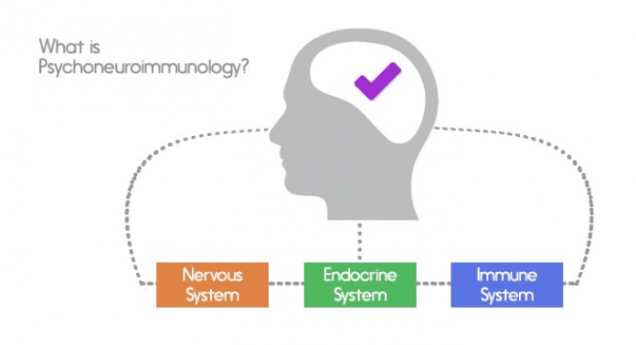Category: Uncategorized
Psychoneuroimmunology: A New Approach to Curing Diseases
When one thinks of disease and cures for it, people typically think medicine or other pharmacological interventions to prevent the disease from spreading or killing it entirely. People also tend to associate physical symptoms as being mainly in part due to the immune system and have little regard toward the neurological approaches to the disease. Now over the past decade, a new approach to diseases is surfacing and gaining more evidence as time goes on: psychoneuroimmunology. Psychoneuroimmunology is a new approach to diseases which involves taking control of the disease by controlling stress and lessening it. Diseases and illnesses untreatable by drugs or medicine could be treated by just understanding and influencing the psychology of the given individual. Psychology has an impact in grieving, cancer, HIV, and wound healings, making it possible for the patient to not suffer in pain but gradually heal over time or increase their outlook on life.
Robert Adler, father of psychoneuroimmunology, first discovered this when he was working on different experiments using Pavlonian conditioning where he involved rats. He found out the conditioning had both a psychological effect via avoidance as well as a neurological and biological effect, as the effects of the drug were shown through both the injected and non-injected rats. From this psychoneuroimmunology was born. As research progressed, more evidence was found, such as in 1981 in David Felten’s lab where he found a relationship between nerves and the cells of the immune system, showing that they actually contact each other directly, through the HPA Axis, which are the glands that secrete hormones in your blood. Ultimately, they are all determined by one’s stress levels.
There have been more studies proving psychoneuroimmunology’s effects on the conditions and immune system of the body. On August 2012, it was reported that Steve Cole, member of the Cousins Center for Psychoneuroimmunology, conducted a study where they ran a mindfulness-based stress reduction study, where patients were told to focus on now and not about the future or the past. This not only reduced lonely feelings, but also altered gene and protein markers of inflammation, which, if accumulated, could lead to the risk of heart disease, showing its overall effect on the immune system. Another study by the same group was also conducted which found that those with a meaningful or purposeful outlook on life had a better gene expression than those who were materialistically happy or those who were facing problems. While this is a study of much needed research, many advances are being made in this new and exciting field.
~ Albert Wang
Sources:
Psychoneuroimmunology: Laugh and Be Well
Meditation Reduces Loneliness and Expression of Inflammatory Genes
Immunology: The Pursuit of Happiness
Photo Source:
The Science Behind Senioritis
We’ve all heard of Senioritis - “a general apathy towards school work that is developed after years of schooling at an institution” (McMullen). However, is this an actual biological phenomenon? Or is it simply an excuse for lazy students to not work hard anymore? The answer may be a bit of both. Although there are ways to overcome Senioritis, research suggests that levels of dopamine in the brain can be linked to whether a person is a slacker or a go-getter.
According to a study put forth by Vanderbilt University, high levels of dopamine in many regions of the brain are associated with a high work ethic. However, there is a strong negative correlation between dopamine levels and work ethic in the anterior insula. The results of this study showed that hardworking people have high levels of dopamine in the two parts of the brain most known for their role in reward and motivation, and low dopamine levels in the anterior insula, which is linked to motivation and risk perception. Therefore, these results may mean that the choice between being a slacker or a go-getter is actually dependent on how the brain weighs risks and rewards. Perhaps then Senioritis could actually be explained by a change in dopamine levels in the three noted regions of the brain. Unfortunately, more research would be needed in order to support this conclusion.
Meanwhile, how do we, exhausted seniors who are ready to move on with our lives, push past Senioritis in order to perform to the best of our ability and enjoy what’s left of this last semester of our college careers? Here are 5 ideas that you may find helpful:
1) Challenge yourself to try something new every week. Whether they be on campus or in the community, chances are there are many events going on every week that you don’t even know about. Take the time to search for something new to do, and then challenge yourself to go with an open mind. Not only would that push you out of your comfort zone and possibly even get you out of your funk, but you could also discover a new passion or hobby.
2) Do something physical. Often times, feeling apathetic can make us feel physically tired. Not only will exercising improve your health, but it can also help you de-stress and increase your energy.
3) Mentor an underclassman. By the time you are a senior, you (hopefully) have quite a bit of it all figured out. You’ve learned what it takes to succeed and what to strive towards. Share this knowledge with others who may be struggling to figure it out on their own. Not only will this help them, but it will also help you reflect on how far you’ve come and, hopefully, will allow you to regain some perspective.
4) Start early. I know - procrastination and senior year seem to go together like a lock and a key. However, procrastination can be the difference between graduating and spending an extra semester in college because you failed a class. It’s not worth it! Plus - and I know I’m about to sound like your mother here - the sooner you finish your work, the sooner you can go out with friends and enjoy the rest of your college time together.
5) Stay organized. Know your goals and create a strategy to achieve them. Create a calendar with all of your classes, volunteering, work, office hours, exams, and homework due dates, along with anything else you need to remember. Set reminders on your phone or write yourself notes and tape them all over your room (Yes Mom, I did learn eventually) - whatever works for you. Make sure to check your schedule for the next day the night before to make sure you aren’t forgetting anything.
Most importantly though, enjoy your senior year! We are about to undergo a major life change that not everybody has the privilege of having. Try to appreciate what you have and take advantage of every opportunity you can. Work hard, make memories, and follow this link for a countdown to BU’s commencement ceremony!
Good luck Seniors! We’re almost there!
~ Alexa Aaronson
Sources:
5 Tips to Battle College Senioritis
Slacker or Go-Getter? Brain Chemical May Tell
Beating Stress
With finals week approaching, stress levels are at an ultimate high. Stress can manifest in physical and psychological symptoms such as headache, impaired concentration, and change in eating and sleeping habits, which are all factors that can negatively impact one's performance. Methods to manage anxiety during this stressful time include getting enough sleep, having a stress outlet, finding an effective study strategy, exercising, and taking short breaks from studying. Besides these strategies, studies have shown that listening to music is also an effective way of reducing stress.
In response to stress, the adrenal gland releases a hormone called cortisol as part of the fight-or-flight mechanism. Cortisol regulates blood pressure and the immune system, allowing the body to spend more energy on other functions. In times of prolonged stress, high cortisol levels can cause sleep abnormalities and reduced immune response, as well as interfere with learning and memory.
Chanda and Levitin analyzed the results of up to 400 studies to determine the effects of music on stress. In one study, researchers simulated stressful situations associated with school and work and measured subjects' levels of stress at different times, post-stressor. They found that the cortisol levels for subjects who listened to relaxing music lowered at a quicker rate than the silent control. Another study involved patients who were about to undergo invasive surgery. Patients were randomly assigned to either listen to music or to take anti-anxiety drugs. Participants were asked to rate their own anxiety and researchers measured levels of cortisol. Results showed that the group that listened to music had lower cortisol levels than the group that took anti-anxiety medication.
In addition to having positive effects on the psychological stress response, music has also been shown to improve the autonomic nervous system’s response to stress. A study by Thoma et al compared the effects of different sounds on the level of stress. The three different conditions included relaxing music, the sound of rippling water, and a control with no acoustic stimulation. The salivary cortisol and alpha-amylase, heart rate, respiratory sinus arrhythmia, and subjective stress and anxiety perception were measured repeatedly. Researchers found that after the stressor, the salivary alpha-amylase baseline values were reached at a much faster rate for participants who listened to relaxing music compared to participants who did not have any acoustic stimulation.
In conclusion, simply listening to relaxing music can be a very effective way of reducing stress and avoiding the negative symptoms that can decrease productivity during this last week of the semester.
~ Sophia Hon
Sources:
Surviving Stress and Anxiety in College and Beyond
The Effect of Music on the Human Stress Response
Image by CDC [Public domain], via Wikimedia Commons
Does Thanksgiving Turkey Really Make You Tired?
Thanksgiving traditions tend to vary from house to house, but one thing seems to remain constant: turkey. We stuff ourselves with turkey and (possibly) cranberry sauce, as if its our last supper. A common desire after eating is to nap - as if eating is a strenuous activity. A well known explanation for this is that the turkey we eat is high in tryptophan, which makes us sleepy; is this true?
What is tryptophan? It is an amino acid obtained through the diet, and is found in all poultry. This amino acid is a precursor to the neurotransmitter serotonin, which plays a role in mood regulation and relaxation. Serotonin is also a reagent in the synthesis of melatonin, a hormone which controls sleep cycles. In theory, this would explain why eating turkey could induce a certain sense of drowsiness.
However, because other types of poultry do not induce this same sensation, despite the fact that they may house larger amounts of tryptophan, the above explanation is implausible. It turns out that foods rich in tryptophan need be accompanied by foods high in carbohydrates to affect serotonin levels. Carbohydrates help transport the fairly bulky tryptophan across the blood-brain barrier so that it can regulate serotonin levels. Therefore, eating stuffing, potatoes, yams, or any other form of carbohydrate together with turkey during Thanksgiving dinner is what increases the serotonin level.
The main cause of grogginess after a hearty Thanksgiving meal is overeating. Overeating causes the digestive system to use more energy than it usually would, resulting in a sense of light fatigue. Between this, the alcohol (a central nervous system depressant) and family drama, of course you'd be ready for bed! As it turns out, the turkey, and therefore the tryptophan, is not the only culprit of this Thanksgiving feast fatigue - your third serving is too!
So the lesson here is...everything in moderation (including turkey).
~ Alexa Aaronson
The Truth about Tryptophan: http://www.webmd.com/food-recipes/the-truth-about-tryptophan?/page=3
Thanksgiving Myth Busted: Eating Turkey Won't Make You Sleepy: http://www.livescience.come/41542-thanksgiving-myth-busted-eating-turkey-won-t-make-you-
Does Eating Turkey Make You Sleepy? http://chemistry.about.com/od/holidaysseasons/a/tiredturkey.htm
Winter Blues or PMS?
Women have a pretty bad rep when it comes to hormones. We get it all the time, in memes, as jokes in TV shows, or in the form of the amusing side comment, “It’s that time of the month again, eh?” with a crass wink. Yes yes, females have a tendency to be moody. For whatever reason, this is a theme present throughout our genetic makeup. A recent study conducted at Indiana University shows that seasonal changes, particularly the fall to winter transition, are associated with a rise in aggressive behavior in female hamsters as opposed to male hamsters. This study revealed new mechanisms by which sex hormones are influenced by the nervous system and provides a model from which we can further study the male and female nervous systems.
The experimenters singled out melatonin as the hormone stimulating female adrenal glands to release hormones acting in place of the hormones released from the gonads. Things do not work this way for male hamsters when there’s a change of season. In females, they found some strange things about this system. The adrenal glands normally release an aggression hormone, DHEA, in response to the release of another hormone, ACTH, secreted by the pituitary gland. Once this seasonal change kicks in however, melatonin is the hormone that stimulates the release of DHEA, and it completely skips past the pituitary gland.
One group of hamsters in this experiment was exposed to the shorter day conditions of winter for ten weeks and then observed for aggressive behaviors. Not only were the female hamsters more aggressive than the males and the control group, but their chemistry had also changed. These aggressive ladies had higher levels of DHEA and melatonin in their bloodstreams and also displayed physical changes in their adrenal glands.
Given that hamsters happen to have similar adrenal systems to humans, these results give us much greater insight into how our own adrenal systems function and how they could be affected throughout the year. While it hasn’t been experimentally proven that these findings can be applied to humans as well, I think it definitely explains away my aggressive feelings during the cold dark months.
~ Jackie Rocheleau
http://www.sciencedaily.com/releases/2015/11/151118070754.htm
http://rspb.royalsocietypublishing.org/content/282/1819/20152080
Language and the Child’s Brain
You may have heard that it is a good idea for children to learn more than one language at a young age (especially toddlers) and that children learn languages more easily than adults. Why is it though, that learning early is advantageous for children? And is the claim that it is easier for children to learn languages than it is for adults true?
Like any other muscle, the more the brain exercises, the stronger it becomes. One way to strengthen the brain is by learning a language, memorizing rules and vocabulary. Research shows that children who learn additional languages have more creativity and flexibility and also possess better critical thinking skills compared to their non-foreign language learning peers, as these children outperform their peers in both verbal and mathematics standardized testing. Children should also learn more than one language because the brain is more open to new sounds and patterns at a young age, so children can mimic new sounds and adopt pronunciations more easily than adults.
Now, whether or not children learn language more easily than adults is up for debate. According to the much-debated “critical period hypothesis,” language development is similar to other forms of development, such as visual development, in that it has a critical period. At this critical period between childhood and adolescence, children can easily learn language, but when this period ends, learning becomes more difficult. Also, if a child fails to learn any language during this period, then the child’s capacity to develop language is permanently damaged and the neural basis for language development degenerates. Since this is only a hypothesis with limited evidence, whether or not this critical period actually exists is unknown. In any case, it certainly can’t hurt for a child to learn more than one language early and receive the clear mental benefits as a result.
~ Nathaniel Meshberg
Sources:
http://www.telegraph.co.uk/education/educationopinion/11151726/Children-should-start-learning-languages-at-age-three.html
http://www.forbes.com/2005/10/19/chomsky-noam-language-learning-comm05-cx_de_1024chomsky.html
The Myths Behind Migraines
A migraine headache is a severe unilateral and pulsating discomfort that is associated with extreme sensitivity to light, sound, smell, taste, and touch that generally lasts between 4 and 72 hours. According to Daniela Pietrobon and Jord Striessnig in “Neurobiology of Migraine,” migraines affect 6-8% of men and 15-25% of women in western countries. At least 1% of the population has a minimum of one day of migraine per week – which means around 2.5 million people in North America are sufferers. In fact, migraines are currently ranked as one of the most disabling chronic disorders. With such a high prevalence, it may seem peculiar how little is known about this condition. However, with the help of recent experimental studies, we are beginning to advance our understanding of the physiological and biological factors that contribute to triggering a migraine. Unfortunately, due to the lack of knowledge about this disease, there are many myths associated with it. I shall address some of these myths in the hope of broadening the general understanding of both the disease and its sufferers.
Myth 1: Migraines are simply bad headaches exaggerated by the sufferer.
Truth: Unfortunately, this is a common creed adopted by a vast majority of both the general public and many physicians. For the past century, there has been negative stigma placed on migraine sufferers. Society has long placed the blame of migraines on migraineurs, believing that their migraines are nothing more than headaches that are exaggerated by their sufferers and caused by stress. This is false. According to M.A.G.N.U.M., the National Migraine Association, “migraine is a disease, a headache is only a symptom.” A migraine sufferer can experience “nausea, vomiting, auras (light spots), sensitivity to light[, scent,] and sound, numbness, difficulty in speech, and severe semihemispherical head pain.” In addition, it is important to note that the cause of migraine pain has been found to be the opposite of the cause of most non-migranous headaches. Migraine pain is generally caused by the dilation of blood vessels in the brain, while other typical headaches appear to result from vasoconstriction. Further, migraines have been found to be genetically linked, where an individual has a 50% chance of suffering from migraines if one of his or her parents is a migraineur.
Myth 2: Migraines are caused solely by psychological factors.
Truth: While stress, depression, and anxiety can all worsen the symptoms of a migraine, they are rarely the sole cause. According to M.A.G.N.U.M., “migraine is a neurological disease, not a psychological disorder.” A migraine is a result of vasodilation in the cranial blood vessels, resulting in an overstimulation of the nerve synapses. Furthermore, migraines can be triggered by both controllable and uncontrollable factors. Controllable stimulants can include bright lights, loud noises, strong scents, and various foods (notably those that are aged or nitrate-latent). Uncontrollable triggers can include hormone changes and weather variations, including fluctuations in barometric pressure, temperature, and humidity. One can often lessen the risk of incidence of a migraine attack by reducing the controllable triggers. However, this is not always enough to fully prevent a migraine spell.
Myth 3: Any doctor should be able to effectively recognize and properly treat migraines.
Truth: Although members of the medical community are generally highly knowledgeable in their fields, migraines still remain one of the most misdiagnosed and mistreated diseases today. This is primarily due to the inherent lack of knowledge about and overall awareness of migraines and their symptoms. M.A.G.N.U.M. goes on to say that, “In fact, 60% of women and 70% of men with migraines have never been diagnosed with this disease.” These migraine sufferers are often misdiagnosed with clinical depression and/or other psychological disorders, leading doctors to mistreat them with various prescription drugs. Hopefully, as our understanding of this disease grows, we can educate both the medical community and the general public about migraines, in an attempt to vastly increase correct diagnoses and treatments.
According to Dr. Silberstein, M.D., F.A.C.P., Co-Director, The Comprehensive Headache Center at Germantown Hospital and Medical Center, in a letter to M.A.G.N.U.M., “Migraine sufferers must not only cope with their pain, but also with society’s misunderstanding of the disorder.” Therefore, both knowledge and education are paramount in the fight of ridding the stigmas surrounding this disease.
- Alexa Aaronson
Sources:
Migraines: Myth Vs. Reality
<http://www.migraines.org/myth/mythreal.htm>
Migraines and Headaches: Overview & Facts
<http://www.webmd.com/migraines-headaches/guide/migraines-headaches-overview>
Neurobiology of Migraine
<http://physiology.elte.hu/gyakorlat/cikkek/Neurobiology%20of%20migraine.pdf>
Read You Like a Book
When I read a book, I get so immersed in the lives of the characters, I find myself anxious and on edge even though I know Katniss’ and Peeta’s tragic romantic life have no bearing on my reality. The fact that characters fabricated from mere words can have this effect on us is pretty incredible. Roel Willems and Annabel Nijhof thought so too apparently, as they recently published a study revealing the neurological effects of listening to audiobooks.
In the experiment, researchers had the subjects listen to chapters of several different audiobooks and recorded their neurological responses using functional Magnetic Resonance Imaging (fMRI). By analyzing the results, Willems and Nijhof determined that the subjects focused most on either the actions of characters or the feelings and intentions of characters. In the subjects that reported to prefer empathizing with the characters more, the fMRIs showed heightened activity in the anterior medial prefrontal cortex, whereas those that reported enjoying the action aspect of the story more had elevated activity in the motor cortex. More
Nice to…smell you?
Shaking hands dates back centuries, with many cultural explanations to back up the ancient customs. One study suggests that the true reason we shake hands is to find out what this new friend smells like. Why? Smell is a “socially significant chemical signal,” used by many other species in social interactions. The researchers conducting this Weizmann Institute study hypothesize that shaking hands is a subliminal way for us to register the smell of others, a primal social custom that survived evolution.
To begin the experiment, the researchers needed to determine if a handshake was enough to transfer detectable body odor. One subject wore a glove on their right hand and the other did not. When the glove was tested after the two subjects shook hands, odor residues containing “meaningful chemical signals” were found on the glove. The next step was to determine the amount of time (if any) spent sniffing the right hand after shaking hands. Around three hundred volunteers, unaware of the purpose of the experiment, were greeted by researchers via a handshake. Surveillance cameras in the room recorded the scene and showed how much time subjects spend sniffing their hands after the encounter. To ensure the subjects were actually subconsciously smelling their hands, nasal air flow was also recorded.
Food Addiction- Why You Can’t Eat Just One Oreo

Nothing is better than satisfying a craving for junk food. Be it Oreos, chips, or chocolate, digging into your favorite snack is probably the best feeling in the world. But what happens when junk food stops becoming a guilty pleasure and instead becomes a real addiction?
Research has discovered that sugar is more addictive than cocaine and that your brain becomes addicted to its own release of opioids in the reward system. The reward system in our brains evolutionarily benefited us by rewarding us for engaging in behavior that encouraged our survival. Thus, when we eat, the neurotransmitter dopamine (usually associated with happiness and pleasure) is released, causing the happy feeling you get when you satisfy a craving.
The world that we live in is one of easy access to sugar-rich foods and has lead to the normalization of overly sweet and processed foods in our everyday lives. Just like any addiction, tolerance to a substance may occur. In this case, constantly activating the reward system and releasing dopamine by continuously eating junk food can cause dopamine receptors to down-regulate. At this point, dopamine receptors are removed by the brain to maintain a balanced state. Fewer dopamine receptors prevent the same stimulation/effect created by dopamine release; thus we tend to eat more junk food to reach the same level of pleasure as before.
More








